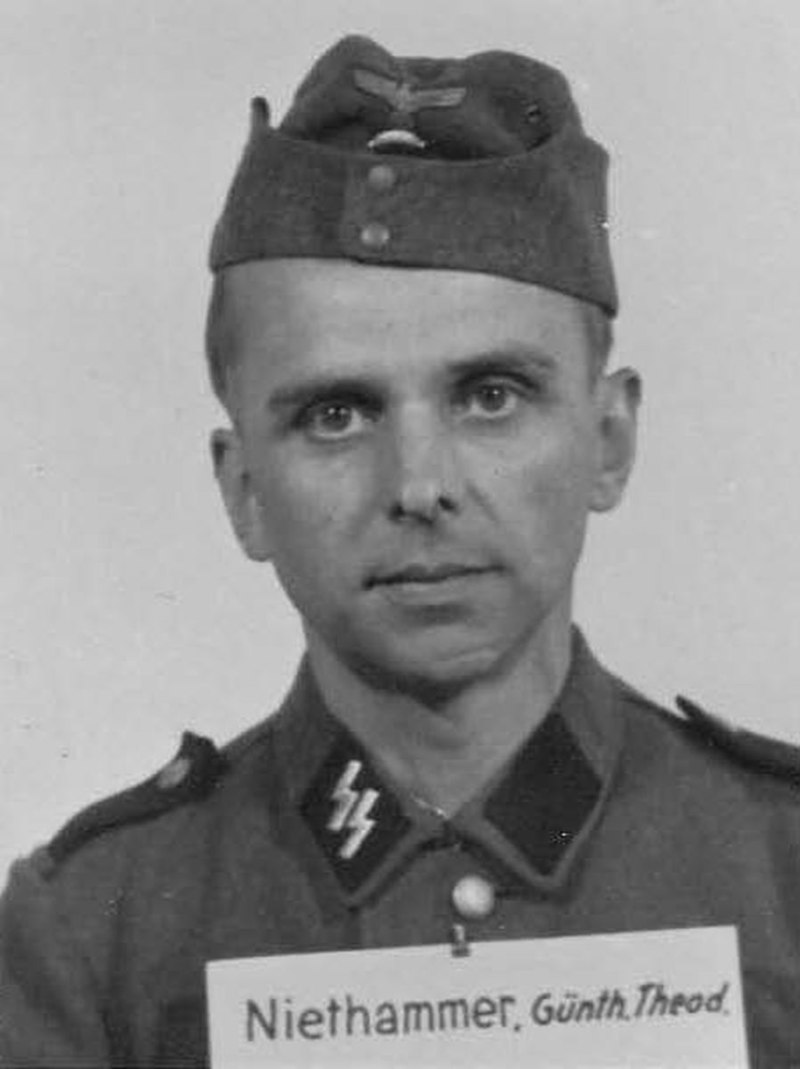Günther Niethammer
(Waldheim, German Empire 1908 – Morenhoven, West Germany 1974): The ornithologist at Auschwitz
“Observations on the bird life in Auschwitz”

Günther Niethammer was born on 28 September 1908 into an upper middle-class family in Saxony. He studied zoology in Tübingen and Leipzig from 1927–1933 and went on to specialise in the field of ornithology. In 1937 Niethammer joined the Nazi Party and became curator at the Alexander König Zoological Research Museum in Bonn. At the same time, his teacher Erwin Stresemann tasked him with the compilation of a “Handbook of German Ornithology”. Niethammer published this three-volume work, which is still considered one of the standard works of German ornithology, in the years 1937 to 1942.
Niethammer profited from his network of prominent ornithologists, who had either acquiesced to the Nazi regime or were Nazis themselves. Besides Stresemann, most important was Hans Kummerlöwe, who had already been on ornithological expeditions to Turkey with Niethammer in 1933. It was thanks to Hans Kummerlöwe that Günter Niethammer was appointed curator of the bird collection of the Natural History Museum in Vienna in 1940. For Niethammer, however, Vienna would only be a stopover; he saw the chance of extended expeditions as his main opportunity to distinguish himself as a scientist during the war.
After being rejected by the Luftwaffe for being too old, Niethammer joined the Waffen-SS and, in October 1940, volunteered for guard duty at Auschwitz concentration camp. His worked there as a guard for a relatively short period, having obtained permission from camp commandant Rudolf Höß in March 1941 to conduct ornithological studies in the area surrounding the camp.
In addition to observing birds, which he shot and prepared himself (or had prepared by others), he took the opportunity to shoot game for the SS to earn some extra money. In May 1942, his essay “Observations on Birdlife in Auschwitz” (Beobachtungen über die Vogelwelt in Auschwitz) was published in the Annals of the Natural History Museum in Vienna. The specimens prepared by Niethammer were intended for the planned natural history department in the SS museum at the Auschwitz I main camp, but were also sent to the Natural History Museum in Vienna. Niethammer remained in Auschwitz until October 1942, punctuated, however, by an extended research trip he made with the Science Department of the Supreme Command of the Wehrmacht to German-occupied Greece.
After another short stay at Auschwitz between September and October 1942, Niethammer was finally recalled and transferred to the SS Sonderkommando “K” under Ernst Schäfer, who conducted expeditions as a leading member of the “Research Community for German Ancestral Heritage”. Further expeditions not only took him to Crete and in Spain, but also yielded a number of scientific publications. In 1944, after the Sonderkommando was disbanded, Niethammer was finally transferred to the Hygiene Institute of the Waffen-SS in Berlin as a zoologist; further expeditions to Bulgaria and Trieste followed.
After the war, Niethammer went into hiding, often changing professions, but it was not long before he was planning his “return to the exclusively zoological field”, as he informed the director of the Alexander König Museum in writing. The latter had contacted the British military authorities; Niethammer’s voluntary surrender was imperative in order to resume his career. At the beginning of February 1946, Niethammer turned himself in to the Field Security Section in Bonn, was subsequently extradited to Poland and sentenced to eight years imprisonment at the Krakow Auschwitz Trial. Following an appeal lodged in autumn 1948, the sentence was reduced to three years (taking into account pretrial detention). Expelled from Poland in 1949, Niethammer resumed his former role as curator at the König Museum in Bonn in 1950, where he remained for the rest of his professional life. For his trial in Krakow, numerous scientists had issued him so-called denazification certificates, including the agronomist and geneticist Hans Stubbe, who lived in the East Germany after the war. Niethammer died in West Germany on 14 January 1974.
Literature
Norbert Frei et al. (ed.), Standort- und Kommandanturbefehle des Konzentrationslagers Auschwitz 1940–1945, Munich 2000, p. 45 (relief from duty for Günther Niethammer).
Character reference for Günther Niethammer from Hans Stubbe, 3.3.1947 (copy), Archive of the Berlin-Brandenburg Academy of Sciences, NL H Stubbe, corr., no. 146 (denazification certificate Hans Stubbe).
Günther Niethammer, Beobachtungen über die Vogelwelt von Auschwitz (Ost-Oberschlesien). In: Annalen des Naturhistorischen Museums in Wien, 52 (1941, ed. May 1942), p. 164–199: https://www.zobodat.at/pdf/ANNA_52_0164-0199.pdf (17.12.2021).
Hans Kumerloeve, Günther Niethammer, dem Freunde und Kollegen, zum Gedächtnis. In: Bonner Zoologische Beiträge, booklet 1—3, 25 (1974), p. 17–22.
Ernst Klee, Auschwitz. Täter, Gehilfen, Opfer und was aus ihnen wurde. Frankfurt am Main 2013, p. 300.
Eugeniusz Nowak, Wissenschaftler in turbulenten Zeiten. Erinnerungen an Ornithologen, Naturschützer und andere Naturkundler, Hohenwarsleben 2010 (= Die neue Brehm-Bücherei, vol. 676), p. 69 ff.
Eugeniusz Nowak, Erinnerungen an Ornithologen, die ich kannte. In: Journal für Ornithologie 139 (1998), p. 325–348, here p. 338 f (= Vortrag vor der 130. DO-G-Jahresversammlung in Neubrandenburg am 28. September 1997): https://vdocuments.mx/reader/full/erinnerungen-an-ornithologen-die-ich-kannte (17.12.2021).
Swen Steinberg, “Birding im KZ”. Biografie, Netzwerke und Deutungen des Ornithologen und SS-Obersturmführers Günther Niethammer. In: Die SS nach 1945. Entschuldungsnarrative, populäre Mythen, europäische Erinnerungsdiskurse, ed. M. Wildt, J.E. Schulte, Göttingen 2018, p. 215–252.
